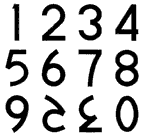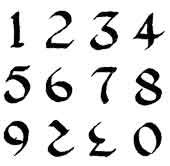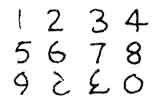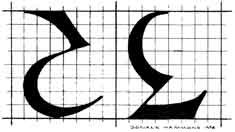



 |
 |
 |
 |
 |
Here is the digit set as envisaged by Don Hammond (for some years Secretary of the DSGB). He devised this slightly different version of the extra symbols. |
This is part of what he wrote in the Dozenal Review.
(Slightly edited. References to old technology, such as the typewriter, omitted)
Most Dozenal Society members will have experienced (perhaps I should say endured!) many attempts to produce dozenal digits, particularly those for ten and elf, and will be rightly wary of further flights of fancy; especially since most of these result in symbols which are inferior to Isaac Pitman's.
However, the idea here presented is the result of a real effort to avoid the bizarre and instead to concentrate on practicality and simplicity; while yet observing the essential arabic style. Thus there is nothing spectacular here: there may, I hope, be something workable and acceptable.
| Broad Pen Script |
|---|
 |
| The broad-pen set contains the two innovations I want to suggest. Compare ten with two, and elf with three; ten now has a sloping bar; elf has a full-width base bar, but an abbreviated crescent. |
| Scribble, pencil or ballpoint) |
|---|
 |
| The modified form of ten given here is less likely to cause confusion: the slope is the key. |
| Calculator display |
|---|
| This now becomes quite easy: |
 |
| The sloping bar of ten will happily stylize into vertical for the seven-bit display. After all, if they can get away with that 4 ... ! |
| The foregoing covers most requirements except those of typefaces for formal or printed work. I have drafted formal designs for the two digits which are now submitted for comment: |
 |
| TEN |
| By tilting the top bar steeply, the vertex is brought down and the serpentine curve eliminated. This effectively removes undue resemblance to an inverted "2", yet retains the essential arabic character of Isaac Pitman's numeral. |
| ELF |
| I have taken the top of the crescent back to the centre-line and lowered the middle vertex, but have made sure that the base bar extends the full width of the containming rectangle. This base is strongly reminiscent of the roman "E", yet does not detract from the arabic form of the digit as a whole. Again, this numeral is rather less like an inverted "3". |
| GENERAL |
| The ratio of width to height in each case is 3:4, which is an excellent arabic proportion ... And dozenal ratio! |